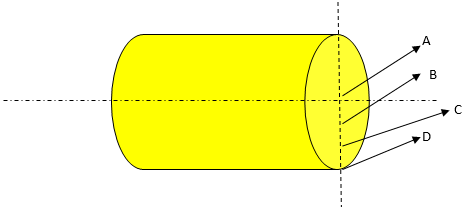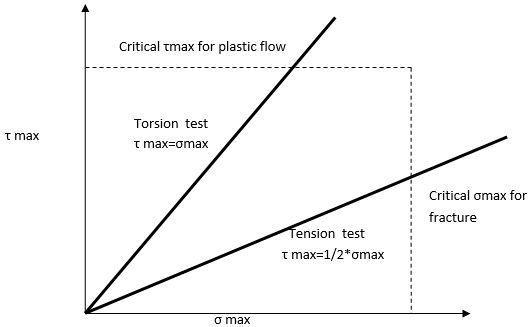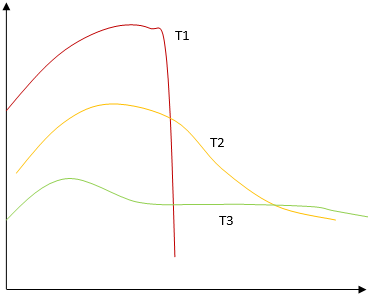This set of Advanced Mechanical Metallurgy Questions and Answers focuses on “Hardness Test – Torsion Stress for Large Plastic Strains”.
1. The torsion test cannot determine __________
a) modulus of elasticity in shear
b) torsional yield strength
c) modulus of rupture
d) tensile strength
View Answer
Explanation: The Torsion test apply shear strength in shear mode, so the only uniaxial tensile properties cannot be determined by the torsion test.
2. The deformation of the specimen is measured by a twist-measurement device called the troptometer.
a) True
b) False
View Answer
Explanation: The device which measures the bending moment of the cylindrical specimen in the torsional test is called the troptometer.
3. In the following torsional test sample, the highest shear stress will be at point ________

a) A
b) B
c) C
d) D
View Answer
Explanation: The shear stress will be zero in the center of the cylinder, and it will be maximum at the circumference or the surface of the cylinder. So, in this case, at point D, the shear stress will be maximum.
4. The maximum shear stress for a solid cylindrical bar having diameter D, and torsional moment equal to M will be _______
a) 16M/πD3
b) 16M/πD4
c) 8M/πD
d) MD
View Answer
Explanation: The Shear stress is equal to
-> M*r/J; Where M is the torsional moment, r is the distance of the point from the center of the cylinder, J is the moment of inertia.
-> So J=πD4/32
The shear stress will be maximum when the r is equal to D/2 or at the surface of the cylinder.
So, substitute the values in the equation;
-> M*r/J = 16M/πD3.
5. In the torsion test, the obtained data are with respect to _____________________
a) stress vs. strain
b) shear stress vs. strain
c) shear stress vs. Shear strain
d) twisting moment vs. Angle of twist
View Answer
Explanation: The primary as in tensile test are load vs. elongation; similarly in torsion test, they are Twisting angle vs. the angle of twist.
6. For calculating the modulus of rupture from the thin-walled hollow cylinder, the diameter to wall thickness ratio should be in the order of __________
a) 10-20
b) 50-100
c) 1-2
d) 1000-1500
View Answer
Explanation: To calculate the modulus of rupture from the thin-walled hollow cylinder, the diameter to wall thickness ratio should be in between 10-20. And the proportion of gauge length to width should be about 0.5.
7. The brittle fracture in the torsion test results in ________ geometry.
a) flat facet
b) helical shape
c) cup and cone
d) shear fracture
View Answer
Explanation: The brittle material in the plane is perpendicular to the direction of the maximum tensile stress. This plane bisects the angle between the two planes of the maximum shear stress and makes an angle of 45o with longitudinal and transverse directions; it results in the helical fracture.
8. A torsion test provides a more fundamental study of the plasticity of the metal than the tension test.
a) True
b) False
View Answer
Explanation: Because the torsion test results in shear stress-strain curve and these curves are more fundamental to the plasticity of the material. Also, the tremendous strain values in the material can be obtained with necking or breaking of the sample.
9. Which of the following statement is not correct with respect to the torsion test?
a) σ1 = -σ3; σ2 = 0
b) τmax = 2σ1/2 = σmax
c) ϵmax = ϵ1; ϵ2=ϵ3 = -ϵ1/2
d) ϒ max = ϵ1-ϵ3 = 2ϵ1
View Answer
Explanation: The condition ϵmax=ϵ1; ϵ2=ϵ3 = -ϵ1/2 is valid for uniaxial tension test condition only. The remaining all three options are valid for torsion test.
10. Which of the following statement is correct?
a) Torsion test plastic deformation starts much before compared to tension test
b) tension test failure of material occurs much faster than the torsion test
c) The shear stress value in the torsion test is higher than the tension test
d) The total amount of plastic deformation possible is much higher in tension test than torsion test
View Answer
Explanation: The below figure clearly shows the limit of plastic deformation and limit of fracture. The above curve represents the torsion test, and below curve represents the tension test. So we can observe that plastic flow is smooth in a torsion test, and fracture is much more comfortable in the tension test.

11. The typical test temperature in the hot torsion testing is _________
a) just above room temperature
b) below room temperature
c) above 0.6 Tm; where Tm is melting point
d) just below the melting point
View Answer
Explanation: The working temperature for the hot torsion test is around 0.6 Tm, which is generally above the recrystallization temperature of the material.
12. Match the correct order of the temperature from the following diagram?

a) T1>T2>T3
b) T1<T2<T3
c) T2>T1>T3
d) T3>T1>T2
View Answer
Explanation: At higher temperature, flow stress will be lower and the strain hardening will be minimum. So, the green curve will have the highest temperature and red one will have the least temperature.
Sanfoundry Global Education & Learning Series – Mechanical Metallurgy.
To practice advanced questions and answers on all areas of Mechanical Metallurgy, here is complete set of 1000+ Multiple Choice Questions and Answers.
If you find a mistake in question / option / answer, kindly take a screenshot and email to [email protected]
- Practice Metallurgical Engineering MCQs
- Apply for Metallurgical Engineering Internship
- Check Mechanical Metallurgy Books
- Check Metallurgical Engineering Books
